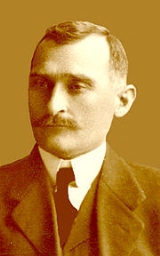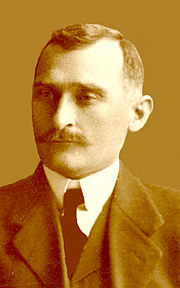
Committee for Independence of Georgia
Encyclopedia

The Committee was formed early in May 1922 as a result of the negotiations of the Georgian Social Democrats (Mensheviks)
Georgian Social Democratic (Menshevik) Party
200px|thumb|Menshevik Flag of Georgia, created by Iakob NikoladzeThe Social Democratic Labour Party of Georgia was a political party in Georgia. It was founded as the Georgian branch of the Russian Social Democratic Labour Party separated itself from the Russian mother-party.The party dominated...
, a former ruling party in pre-Communist Georgia, with its erstwhile political opposition – the National Democratic Party, the Federalist Party, the Social Revolutionaries (SRs) and the Skhivi (“Beam”) Party. Each party was represented by one member in the Damkom (hence the organization’s alternative name, the Parity Committee), which was traditionally chaired by a Menshevik. Gogita Paghava was the first chairman; he was shortly succeeded by Nikoloz Kartsivadze, who was arrested by the Soviet secret police, Cheka
Cheka
Cheka was the first of a succession of Soviet state security organizations. It was created by a decree issued on December 20, 1917, by Vladimir Lenin and subsequently led by aristocrat-turned-communist Felix Dzerzhinsky...
, on 16 March 1923, and was replaced with Kote Andronikashvili. Throughout its existence, the Secretary of the Damkom was Yason Javakhishvili of the National Democratic Party.
The accord signed by the members of the Damkom envisaged the overthrow of the Bolshevik regime through a nation-wide uprising, restoration of the Democratic Republic of Georgia
Democratic Republic of Georgia
The Democratic Republic of Georgia , 1918–1921, was the first modern establishment of a Republic of Georgia.The DRG was created after the collapse of the Russian Empire that began with the Russian Revolution of 1917...
and the formation of a coalition government
Coalition government
A coalition government is a cabinet of a parliamentary government in which several political parties cooperate. The usual reason given for this arrangement is that no party on its own can achieve a majority in the parliament...
. The Committee maintained close contacts with the Government of Georgia-in-exile though its "Constantinople Bureau" based in Istanbul
Istanbul
Istanbul , historically known as Byzantium and Constantinople , is the largest city of Turkey. Istanbul metropolitan province had 13.26 million people living in it as of December, 2010, which is 18% of Turkey's population and the 3rd largest metropolitan area in Europe after London and...
, Turkey
Turkey
Turkey , known officially as the Republic of Turkey , is a Eurasian country located in Western Asia and in East Thrace in Southeastern Europe...
. The Committee set up a military center chaired by the retired general Kote Abkhazi
Kote Abkhazi
Prince Konstantine "Kote" Abkhazi , was a Georgian military officer and politician. During the Imperial Russian rule, he was a general in the tsar's army, and a recognized leader of the liberal nobility of Georgia. After the Sovietization of Georgia, he emerged as one of the leaders of an...
, who was to prepare for a popular insurrection. Several members of the former Menshevik government returned clandestinely from exile, including the former Minister of Agriculture, Noe Khomeriki
Noe Khomeriki
Noe Khomeriki was a Georgian politician involved in the Social Democrat movement and shot during the Bolshevik Red Terror in the Georgian SSR....
, as well as the former commander of the People’s Guard, Valiko Jugheli
Valiko Jugheli
Vladimir “Valiko” Jugheli was a Georgian politician and military commander.He was involved in the Marxist movement in Georgia at the beginning of the 20th century...
.
The Georgian Cheka, with recently appointed Deputy Chief Lavrentiy Beria
Lavrentiy Beria
Lavrentiy Pavlovich Beria was a Georgian Soviet politician and state security administrator, chief of the Soviet security and secret police apparatus under Joseph Stalin during World War II, and Deputy Premier in the postwar years ....
playing a leading role, managed to penetrate the organization and carried out mass arrests. A heavy loss was sustained by the Georgian opposition in February 1923, when the military center was betrayed by Kote Misabishvili, a student member of the National-Democratic party. Fifteen members of the military center were arrested, among them the principal leaders of the resistance movement: Kote Abkhazi
Kote Abkhazi
Prince Konstantine "Kote" Abkhazi , was a Georgian military officer and politician. During the Imperial Russian rule, he was a general in the tsar's army, and a recognized leader of the liberal nobility of Georgia. After the Sovietization of Georgia, he emerged as one of the leaders of an...
, Alexander Andronikashvili
Alexander Andronikashvili
Alexander Andronikashvili also known as Andronikov was a Georgian military commander and anti-Soviet resistance leader.Of an old noble family, Andronikashvili served in the Imperial Russian army and was promoted to the rank of general in World War I. He then served for the General Staff of the...
, Varden Tsulukidze
Varden Tsulukidze
Varden Tsulukidze was a Georgian military commander and anti-Soviet resistance leader.Of a noble family, Tsulukidze served in the Imperial Russian army and was promoted to the rank of major-general in World War I...
, Colonel Giorgi Khimshiashvili
Giorgi Khimshiashvili
Colonel Giorgi Khimshiashvili was member of Khimshiashvili Dynasty and nephew of Sherip KhimshiashviliThe Committee for the Independence of Georgia or the Parity Committee was an underground anti-Soviet organization active in the Georgian Soviet Socialist...
, Simon Bagration-Mukhraneli, Elizbar Gulisashvili, and Rostom Muskhelishvili; they were executed on 20 May 1923. Khomeriki and Jugheli also fell in the hands of the Cheka and were subsequently shot. After some hesitation, the Committee went ahead and laid plans for a general insurrection for 2.00 am 29 August 1924. The plan of the simultaneous uprising miscarried, however, and, through some misunderstanding, the mining town of Chiatura
Chiatura
Chiatura is a city in the Imereti region of Western Georgia. In 1989, it had a population of about 30,000. It is inland, in a mountain valley on the banks of the Kvirila River, and since 1879 has been a major centre of manganese production in the Caucasus. There is a rail link to transport...
, western Georgia, rose in rebellion a day earlier, on 28 August.
The revolt continued for three weeks in several districts of Georgia and was crushed by the Red Army
Red Army
The Workers' and Peasants' Red Army started out as the Soviet Union's revolutionary communist combat groups during the Russian Civil War of 1918-1922. It grew into the national army of the Soviet Union. By the 1930s the Red Army was among the largest armies in history.The "Red Army" name refers to...
and Cheka forces. The suppression of the uprising was accompanied by large-scale repressions in which several thousands were killed. On 4 September the Cheka discovered the rebels’ chief headquarters at the Shio-Mgvime Monastery
Shio-Mgvime Monastery
The Shio-Mgvime monastery is a medieval monastic complex in Georgia, near the town of Mtskheta. It is located in a narrow limestone canyon on the northern bank of the river Mtkvari , some 30 km from Tbilisi, Georgia’s capital....
near the town of Mtskheta
Mtskheta
Mtskheta , one of the oldest cities of the country of Georgia , is located approximately 20 kilometers north of Tbilisi at the confluence of the Aragvi and Kura rivers. The city is now the administrative centre of the Mtskheta-Mtianeti region...
, and arrested the leaders of the Damkom, including its chairman Andronikashvili. On the same day, Beria met them in Tiflis, and proposed to issue a declaration urging the partisans to put down their arms. The committee members, tied up and facing death themselves, accepted the proposal on the condition that an order to stop mass executions be given immediately. Beria agreed and the rebels signed the declaration in order to put an end to the bloodshed. The persecutions did not end, however, and the arrested opposition leaders themselves were shortly put to death. By mid-September, most of the Damkom’s armed detachments had been destroyed and the uprising defeated.

